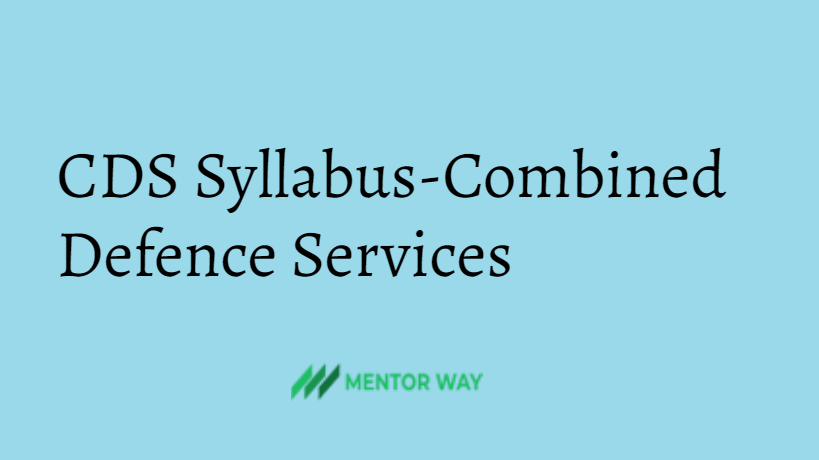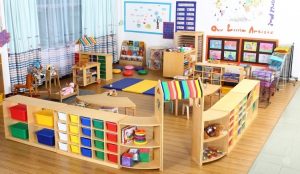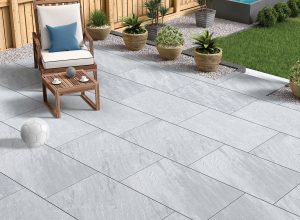CDS Syllabus-Combined Defence Services
6 min read
CDS Eligibility Details: Union Public Service Commission (UPSC) is going to conducts Combined Defence Services (CDS) Examination for recruitment of various vacancies under Indian Military Academy, Indian Naval Academy, Air Force Academy and Officers Training Academy. The following are the eligibility details to apply for the Combined Defence Services Exam.
CDS Eligibility Details:
Nationality:
A candidate must be either
- A citizen of India, or
- A subject of Nepal, or
- A subject of Bhutan, or
- A Tibetan refugee who came over to India before 1st January, 1962 with the intention of permanently settling in India, or
- A person of Indian origin who has migrated from Pakistan, Burma, Srilanka or East African countries of Kenya, Uganda, the United Republic of Tanzania, Zambia, Malawi, Zaire and Ethiopia or from Vietnam with the intention of permanently settling in India.
Provided that a candidate belonging to categories (b), (c), (d) and (e) shall be a person in whose favour a certificate of eligibility has been issued by the Government of India.
Age Limit:
(i) For IMA: Unmarried male candidates born not earlier than 02-01-1996 and not later than 01-01-2001
(ii) For Indian Naval Academy: Unmarried male candidates born not earlier than 02-01-1996 and not later than 01-01-2001.
(iii) For Air Force Academy: Unmarried male candidates age between 20 to 24 years as on 1st January, 2020 i.e. born not earlier than 02-01-1996 and not later than 01-01-2000 (Upper age limit for candidates holding valid and current Commercial Pilot Licence issued by DGCA (India) is relaxable upto 26 yrs.i.e. born not earlier than 02-01-1994 and not later than 01-01-2000).
(iv) For Officers’ Training Academy (SSC Course for Men): Male candidates (unmarried) born not earlier than 02-01-1995 and not later than 01-01-2001.
(v) For Officers Training Academy (SSC Women Non-Technical Course): Unmarried women, issueless widows who have not remarried and issueless divorcees (in possession of divorce documents) who have not remarried are eligible. They should have been born not earlier than 02-01-1995 and not later than 01-01-2001.
Note: Male divorcee/widower candidates can not be treated as unmarried male for the purpose of their admission in IMA/INA/AFA courses and accordingly they are not eligible for these courses.
Educational Qualification:
(i) For I.M.A. and Officers’ Training Academy: Degree of a recognized University or equivalent.
(ii) For Indian Naval Academy: Degree in Engineering from a recognized university/institution.
(iii) For Air Force Academy: Degree of a recognized University (with Physics and Mathematics at 10+2 level) or Bachelor of Engineering.
Note: Those candidates who are studying in the final years Degree course and have yet to pass the final year Degree examination are also eligible to apply.
Physical Standards:
Candidates must be physically fit according to physical standards for admission to Combined Defence Services Examination.
CDS Exam Pattern Details
Union Public Service Commission (UPSC) is going to conducts Combined Defence Services (CDS) Examination for recruitment of various vacancies under Indian Military Academy, Indian Naval Academy, Air Force Academy and Officers Training Academy. The exam pattern of UPSC CDS details given below…
-
Written Exam:
Written Exam consists of Objective Type questions and time duration 02 hrs and maximum marks is 100 for each subject.
For the candidates who are appearing for Indian Military Academy, Naval Academy, Air force Academy written test comprising of English, General Knowledge and Elementary mathematics subjects and for candidates who are appearing for officers training academy the written test comprising of English and General Knowledge.
Candidates who are declared successful in the written exam will be detailed for intelligence and personality test at the Service Selection Board based on their preference, by the respective service HQ.
(A) For Admission to Indian Military Academy, Indian Naval Academy and Air Force Academy:
| Subject | Duration | Maximum Marks |
| English | 2 Hours | 100 |
| General Knowledge | 2 Hours | 100 |
| Elementary Mathematics | 2 Hours | 100 |
(B) For Admission to Officers’ Training Academy:
| Subject | Duration | Maximum Marks |
| English | 2 Hours | 100 |
| General Knowledge | 2 Hours | 100 |
The maximum marks allotted to the written examination and to the interviews will be equal for each course. i.e the maximum marks allotted to the written examination and to the interviews will be 300, 300, 300 and 200 each for admission to the Indian Military Academy, Indian Naval Academy, Air Force Academy and Officers Training Academy respectively.
The papers in all the subjects will consists of objective type questions only. The question papers of General Knowledge and Elementary Mathematics will be set bilingually in Hindi as well as English.
In the question papers, wherever necessary, questions involving the metric system of Weighs and Measures only will be set.
Intelligence & Personality Test:
The candidates who are selected in written test are called for interview. The SSB procedure consists of two stage selection process-Stage I and Stage II. Only those candidates who clear the stage I are permitted to appear for Stage II.
Stage I comprises of Officers Intelligence Rating (OIR) tests are Picture Perception Description Test (PP&DT). The candidates will be shortlisted based on the combination of performance in OIR Test and PP&DT.
Stage II comprises of Interview, Group Testing Officers Tasks, Psychology Tests and the conference. These tests are conducted over 4 days.
The personality of a candidate is assessed by three different assessors viz. the interviewing Officer (IO), Group Testing Officer (GTO) and the Psychologist. There are no separate weightage for each test. The marks are allotted by assessors only after taking into consideration the performance of the candidate holistically in all the test.
CDS Syllabus Details:
Union Public Service Commission (UPSC) is going to conducts Combined Defence Services (CDS) Examination for recruitment of various vacancies under Indian Military Academy, Indian Naval Academy, Air Force Academy and Officers Training Academy. The CDS syllabus details is given below.
PAPER – 1: ENGLISH:
The question paper will be designed to test the candidates’ understanding of English and workmanlike use of words.
PAPER – 2: GENERAL KNOWLEDGE:
General Knowledge including knowledge of current events and of such matters of everyday observation and experience in their scientific aspects as may be expected of an educated person who has not made a special study of any scientific subject. The Paper will also include questions on History of India and Geography of nature which Candidate should be able to answer without special study.
PAPER – 3: ELEMENTARY MATHEMATICS:
Arithmetic:
Number System-Natural numbers, Integers, Rational and Real numbers. Fundamental Operations addition, subtraction, multiplication, division, Square roots, Decimal, fractions. Unitary method, time and distance, time and work, percentages, applications to simple and compound interest, profit and loss, ratio and proportion, variation.
Elementary Number Theory:
Division algorithm. Prime and composite numbers. Tests of divisibility by 2, 3,4,5,9 and 11. Multiples and factors. Factorization Theorem. H.C.F. and L.C.M. Euclidean algorithm, Logarithms to base 10, laws of logarithms, use of logarithmic tables.
Algebra:
Basic Operations, simple factors, Remainder Theorem, H.C.F., L.C.M. Theory of polynomials, Solutions of quadratic equations, relation between its roots and coefficients (Only real roots to be considered). Simultaneous linear equations in two unknowns-analytical and graphical solutions.
Simultaneous linear in equations in two variables and their solutions. Practical problems leading to two simultaneous linear equations or in equations in two Variables or quadratic equations in one variable & their solutions. Set language and set notation, rational expressions and conditional identities, Laws of indices.
Trigonometry:
Sine x, cosine x, Tangent x when 0 ≤x ≤90 Values of sin x, cos x and tan x, for x = 0, 30, 45, 60 and 90
Simple trigonometric identities.
Use of trigonometric tables. Simple cases of heights and distances.
Geometry:
Lines and angles, Plane and plane figures, Theorems on (i) Properties of angles at a Point, (ii) Parallel lines, (iii) Sides and angles of a triangle, (iv) Congruency of triangles, (v) Similar triangles, (vi) Concurrence of medians and altitudes, (vii) Properties of angles, sides and diagonals of a parallelogram, rectangle and square (viii) Circles and its properties including tangents and normal, (ix) Loci.
Mensuration:
Areas of squares, rectangles, parallelograms, triangle and circle. Areas of figures which Can be split up into these figures (Field Book), Surface area and volume of cuboids, lateral surface and volume of right circular cones and cylinders, surface area and Volume of spheres.
Statistic:
Collection and tabulation of statistical data, Graphical representation, frequency Polygons, histograms, bar charts, pie charts etc. Measures of central tendency.
Hope you liked this article. For more articles like this, keep visiting Mentor Way.



